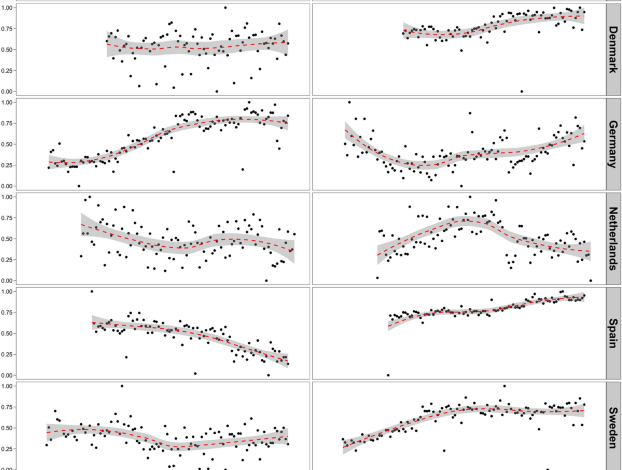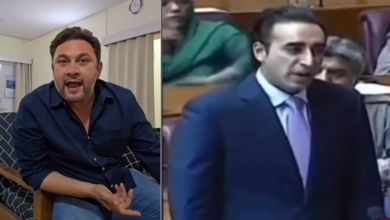Tone in politics is not systematically related to macro trends, ideology, or experience

Soroka, S. N. Negativity in Democratic Politics: Causes and Consequences (Cambridge University Press, 2014).
Külz, J., Spitz, A., Abu-Akel, A., Günnemann, S. & West, R. United States politicians’ tone became more negative with 2016 primary campaigns. Sci. Rep. 13(1), 10495 (2023).
Lengauer, Günther., Esser, Frank & Berganza, Rosa. Negativity in political news: A review of concepts, operationalizations and key findings. Journalism 13(2), 179–202 (2012).
Rhodes, J. H. & Vayo, A. B. The historical presidency: Fear and loathing in presidential candidate rhetoric, 1952–2016. Pres. Stud. Q. 49(4), 909–931 (2019).
Caryl, C. The world is awash in the politics of fear. The Washington post (2018).
Davies, W. How feelings took over the world. The Guardian (2018).
Freeman, J. America descends into the politics of rage. The Atlantic (2018).
Albert Arnold Gore. The Assault on Reason: How the Politics of Blind Faith Subvert Wise Decision-Making (The Penguin Press, 2007).
Erisen, C. & Villalobos, J. D. Exploring the invocation of emotion in presidential speeches. Contemp. Politics 20(4), 469–488 (2014).
Ojala, Maria, Cunsolo, Ashlee, Ogunbode, Charles A. & Middleton, Jacqueline. Anxiety, worry, and grief in a time of environmental and climate crisis: A narrative review. Annu. Rev. Environ. Resour. 46(1), 35–58 (2021).
Stapleton, Carey E. & Dawkins, Ryan. Catching my anger: How political elites create angrier citizens. Political Res. Q. 75(3), 754–765 (2022).
Werlen, E., Imhof, C., & Bergamin, P. Emotions in the parliament: Lexical emotion analysis of parliamentarian speech transcriptions, in SwissText (2021).
Lau, R. R. & Pomper, G. M. Effects of negative campaigning on turnout in U.S. senate elections, 1988–1998. J. Politics 63(3), 804–819 (2001).
Hobbs, William & Lajevardi, Nazita. Effects of divisive political campaigns on the day-to-day segregation of Arab and Muslim Americans. Am. Political Sci. Rev. 113(1), 270–276 (2019).
Jordan, K. N., Sterling, J., Pennebaker, J. W. & Boyd, R. L. Examining long-term trends in politics and culture through language of political leaders and cultural institutions. Proc. Natl. Acad. Sci. U.S.A. 116(9), 3476–3481 (2019).
Crabtree, C., Golder, M., Gschwend, T. & IndriĐason, I. H. It is not only what you say, it is also how you say it: The strategic use of campaign sentiment. J. Politics 82(3), 1044–1060 (2020).
Osnabrügge, M., Hobolt, S. B. & Rodon, T. Playing to the gallery: Emotive rhetoric in parliaments. Am. Political Sci. Rev. 115(3), 885–899 (2021).
Wojcik, S. P., Hovasapian, A., Graham, J., Motyl, M. & Ditto, P. H. Conservatives report, but liberals display, greater happiness. Science 347(6227), 1243–1246 (2015).
Kosmidis, S., Hobolt, S. B., Molloy, E. & Whitefield, S. Party competition and emotive rhetoric. Comp. Pol. Stud. 52(6), 811–837 (2019).
Rheault, L., Beelen, K., Cochrane, C. & Hirst, G. Measuring emotion in parliamentary debates with automated textual analysis. PLoS one 11(12), e0168843 (2016).
Schwalbach, J. Going in circles? The influence of the electoral cycle on the party behaviour in parliament. Eur. Political Sci. Rev. 14, 1–20 (2021).
Valentim, V. & Widmann, T. Does radical-right success make the political debate more negative? Evidence from emotional rhetoric in German state parliaments. Political Behav. 45(1), 243–264 (2021).
Widmann, T. How emotional are populists really? Factors explaining emotional appeals in the communication of political parties. Polit. Psychol. 42(1), 163–181 (2021).
Steegen, S., Tuerlinckx, F., Gelman, A. & Vanpaemel, W. Increasing transparency through a multiverse analysis. Perspect. Psychol. Sci. 11(5), 702–712 (2016).
Haselmayer, Martin & Jenny, Marcelo. Sentiment analysis of political communication: Combining a dictionary approach with crowdcoding. Qual. Quant. 51(6), 2623–2646 (2017).
Russell, James A. A circumplex model of affect. J. Pers. Soc. Psychol. 39(6), 1161–1178 (1980).
Lieberman, E., Michel, J. B., Jackson, J., Tang, T. & Nowak, M. A. Quantifying the evolutionary dynamics of language. Nature 449(7163), 713–716 (2007).
Johnson, E. Lexical Change and Variation in the Southeastern United States, 1930–1990 (University of Alabama Press, 1996).
Kozlowski, A. C., Taddy, M., & Evans, J. A. the geometry of culture: Analyzing meaning through word embeddings. Am. Sociol. Rev. 000312241987713 (2019).
Rodman, E. A timely intervention: Tracking the changing meanings of political concepts with word vectors. Political Anal. 28, 1–25 (2019).
Brand, C. O., Acerbi, A. & Mesoudi, A. Cultural evolution of emotional expression in 50 years of song lyrics. Evol. Hum. Sci. 1, e11 (2019).
Iliev, R., Hoover, J., Dehghani, M. & Axelrod, R. Linguistic positivity in historical texts reflects dynamic environmental and psychological factors. Proc. Natl. Acad. Sci. U.S.A. 113(49), E7871–E7879 (2016).
Acerbi, A., Lampos, V., Garnett, P. & Bentley, R. A. The expression of emotions in 20th century books. PLoS one 8(3), 59030 (2013).
Lim, E. T. The Anti-Intellectual Presidency: The Decline of Presidential Rhetoric from George Washington to George W. Bush (Oxford University Press, 2011).
Spirling, Arthur. Democratization and linguistic complexity: The effect of franchise extension on parliamentary discourse, 1832–1915. J. Politics 78(1), 120–136 (2016).
Teten, R. Evolution of the modern rhetorical presidency: Presidential presentation and development of the state of the union address. Pres. Stud. Q. 33(2), 333–346 (2003).
Schoonvelde, Martijn, Brosius, Anna, Schumacher, Gijs & Bakker, Bert N. Liberals lecture, conservatives communicate: Analyzing complexity and ideology in 381,609 political speeches. PLoS one 14(2), e0208450 (2019).
Müller, W. C. & Strøm, K. Policy, Office, or Votes? (Cambridge University Press, 1999).
Lewis-Beck, M. S. Comparative economic voting: Britain, France, Germany, Italy. Am. J. Political Sci. 30(2), 315 (1986).
Traber, D., Schoonvelde, M. & Schumacher, G. Errors have been made, others will be blamed: Issue engagement and blame shifting in prime minister speeches during the economic crisis in Europe. Eur. J. Political Res. 59(1), 45–67 (2019).
Stimson, J. A. Public Opinion in America: Moods, Cycles, and Swings (Taylor and Francis, 1999).
Erikson, R. S., Mackuen, M. B. & Stimson, J. A. The Macro Polity (Cambridge University Press, 2001).
Ekman, P. & Davidson, R. J. The Nature of Emotion (Oxford University Press, Oxford, UK, 1994).
Frey, B. S. & Stutzer, A. What can economists learn from happiness research?. J. Econ. Lit. 40(2), 402–435 (2002).
Easterlin, R. A., McVey, L. A., Switek, M., Sawangfa, O. & Zweig, J. S. The happiness – Income paradox revisited. Proc. National Acad. Sci. U.S.A. 107(52), 22463–22468 (2010).
Hibbing, J. R., Smith, K. B. & Alford, J. R. Differences in negativity bias underlie variations in political ideology. Behav. Brain Sci. 37(3), 297–307 (2014).
Tritt, S. M., Peterson, J. B., Page-Gould, E. & Inzlicht, M. Ideological reactivity: Political conservatism and brain responsivity to emotional and neutral stimuli. Emotion 16(8), 1172–1185 (2016).
Sylwester, K. & Purver, M. Twitter language use reflects psychological differences between democrats and republicans. PLoS one 10(9), e0137422 (2015).
Turetsky, K. M. & Riddle, T. A. Porous chambers, echoes of valence and stereotypes: A network analysis of online news coverage interconnectedness following a nationally polarizing race-related event. Soc. Psycholo. Personal. Sci. 9(2), 163–175 (2018).
Hirsh, J. B. & Peterson, J. B. Personality and language use in self-narratives. J. Res. Pers. 43(3), 524–527 (2009).
Lee, C. H., Kim, K., Young, S. S. & Chung, C. K. The relations between personality and language use. J. General Psychol. 134(4), 405–413 (2007).
Pennebaker, James W. & King, Laura A. Linguistic styles: Language use as an individual difference. J. Pers. Soc. Psychol. 77(6), 1296–1312 (1999).
Yarkoni, T. Personality in 100,000 words: A large-scale analysis of personality and word use among bloggers. J. Res. Pers. 44(3), 363–373 (2010).
Costa, Paul T. & McCrae, Robert R. Influence of extraversion and neuroticism on subjective well-being: Happy and unhappy people. J. Pers. Soc. Psychol. 38(4), 668–678 (1980).
Larsen, R. J. & Ketelaar, T. Personality and susceptibility to positive and negative emotional states. J. Pers. Soc. Psychol. 61(1), 132–140 (1991).
Lucas, R. E. & Diener, E. D. Understanding extraverts’ enjoyment of social situations: The importance of pleasantness. J. Personal. Soc. Psychol. 81(2), 343–356 (2001).
Pavot, W., Diener, E. D. & Fujita, F. Extraversion and happiness. Personal. Individ. Differ. 11(12), 1299–1306 (1990).
Words, O., Selves, O., James, W. P., Matthias, R. M. & Kate, G. N. Psychological aspects of natural language use. Annu. Rev. Psychol. 54, 547–77 (2003).
Bakker, B. N. Personality traits, income, and economic ideology. Polit. Psychol. 38(6), 1025–1041 (2017).
Gerber, A. S., Huber, G. A., Doherty, D., Dowling, C. M. & Shang, E. H. Personality and political attitudes: Relationships across issue domains and political contexts. Am. Political Sci. Rev. 104(1), 111–133 (2010).
Malka, A., Soto, C. J., Inzlicht, M. & Lelkes, Y. Do needs for security and certainty predict cultural and economic conservatism? A cross-national analysis. J. Pers. Soc. Psychol. 106(6), 1031–1051 (2014).
Fournier, P., Soroka, S. & Nir, Lilach. Negativity Biases and political ideology: A comparative test across 17 countries. Am. Political Sci. Rev. 114(3), 775–791 (2020).
Bakker, B. N., Schumacher, G., Gothreau, C. & Arceneaux, K. Conservatives and liberals have similar physiological responses to threats. Nat. Hum. Behav. 4(6), 613–621 (2020).
Ludeke, S., Tagar, M. R. & DeYoung, C. G. Not as different as we want to be: Attitudinally consistent trait desirability leads to exaggerated associations between personality and sociopolitical attitudes: Not as different as we want to be. Polit. Psychol. 37(1), 125–135 (2016).
Hatemi, P. K., Crabtree, C. & Smith, K. B. Ideology justifies morality: Political beliefs predict moral foundations. Am. J. Political Sci. 63(4), 788–806 (2019).
Hatemi, P. K. & Verhulst, B. Political attitudes develop independently of personality traits. PLoS one 10(3), e0118106 (2015).
Ghodeswar, B. M. Building brand identity in competitive markets: A conceptual model. J. Product Brand Manag. 17(1), 4–12 (2008).
Whan Park, C. & Macinnis, D. J. Introduction to the special issue: Brand relationships, emotions, and the self. J. Assoc. Consum. Res. 3(2), 123–129 (2018).
Reeves, P., de Chernatony, L. & Carrigan, M. Building a political brand: Ideology or voter-driven strategy. J. Brand Manag. 13(6), 418–428 (2006).
Dolezal, M., Ennser-Jedenastik, L. & Müller, W. C. Who will attack the competitors? How political parties resolve strategic and collective action dilemmas in negative campaigning. Party Politics 23(6), 666–679 (2017).
Diener, E. D., Sandvik, E. D. & Larsen, R. J. Age and sex effects for emotional intensity. Dev. Psychol. 21(3), 542–546 (1985).
Gross, J. J. et al. Emotion and aging: Experience, expression, and control. Psychol. Aging 12(4), 590–599 (1997).
Frijda, N. H. The laws of emotion. Am. Psychol. 43(5), 349–358 (1988).
Rauh, C., & Schwalbach, J. The ParlSpeech V2 data set: Full-text corpora of 6.3 million parliamentary speeches in the key legislative chambers of nine representative democracies. Harvard Dataverse, v2 edition (2020).
Volkens, A., Krause, W., Lehmann, P., Matthieß, T., Merz, N., Regel, S., & Weßels, B. The manifesto data collection. Manifesto project (MRG/CMP/MARPOR) (2019).
Schumacher, G., Berk, N., Pipal, C., Kantorowicz, J., Schoonvelde, M., Traber, D., & Vries, E. D. EUSpeech V2 (2020).
Gennaro, G. & Ash, Elliott. Emotion and reason in political language. Econ. J. 132(643), 1037–1059 (2022).
Lin, C., & He, Y. Joint sentiment/topic model for sentiment analysis, in International Conference on Information and Knowledge Management, Proceedings, 375–384 (2009).
Lin, C., He, Y., Everson, R. & Rüger, S. Weakly supervised joint sentiment-topic detection from text. IEEE Trans. Knowl. Data Eng. 24(6), 1134–1145 (2012).
Pipal, C., Schoonvelde, M. & Schumacher, G. Taking Context Seriously: Joint Estimation of Sentiment and Topics in Textual Data (Publisher, OSF Preprint, 2021).
Young, L. & Soroka, S. Affective news: The automated coding of sentiment in political texts. Polit. Commun. 29(2), 205–231 (2012).
Proksch, S. O., Lowe, W., Wäckerle, J. & Soroka, S. Multilingual sentiment analysis: A new approach to measuring conflict in legislative speeches. Legis. Stud. Q. 44(1), 97–131 (2019).
Ennser-Jedenastik, L., Dolezal, M. & Müller, W. C. Gender differences in negative campaigning: The impact of party environments. Politics Gender 13, 81–106 (2017).
Hargrave, L. & Langengen, T. The gendered debate: Do men and women communicate differently in the house of commons?. Politics Gender 17, 1–27 (2020).
Canes-Wrone, B. Who Leads Whom?: Presidents, Policy, and the Public (University of Chicago Press, UK, 2010).
Lenz, G. S. Follow the Leader?: How Voters Respond to Politicians’ Policies and Performance (University of Chicago Press, 2012).
Soroka, S. N. & Wlezien, C. Degrees of Democracy: Politics, Public Opinion, and Policy (Cambridge University Press, 2010).
OECD. OECD Stat: Quarterly national accounts (2019).
Döring, H., & Manow, P. Parliaments and governments database (ParlGov): Information on parties, elections, and cabinets in modern democracies. Infrastruct. Empir. Inf. Parties Elections Gov. Mod. Democr. Version 12(10) (2015).
Simonsohn, U., Simmons, J. P. & Nelson, L. D. Specification curve analysis. Nat. Hum. Behav. 4(11), 1208–1214 (2020).
Proksch, S. O. & Slapin, J. B. The Politics of Parliamentary Debate: Parties (Cambridge University Press, 2014).
Bäck, H. & Debus, M. When do women speak? A comparative analysis of the role of gender in legislative debates. Political Stud. 67(3), 576–596 (2019).
Bäck, H., Baumann, M., Debus, M. & Müller, J. The unequal distribution of speaking time in parliamentary-party groups. Legis. Stud. Q. 44(1), 163–193 (2019).
Takens, J., Kleinnijenhuis, J., Van Hoof, A. & Van Atteveldt, W. Party leaders in the media and voting behavior: Priming rather than learning or projection. Polit. Commun. 32(2), 249–267 (2015).
Flachaire, E. A better way to bootstrap pairs. Econ. Lett. 64(3), 257–262 (1999).
Blei, D. M., Ng, A. Y. & Jordan, M. I. Latent Dirichlet allocation. J. Mach. Learn. Res. 3(4–5), 993–1022 (2003).
Lison, P., & Tiedemann, J. OpenSubtitles2016: Extracting large parallel corpora from movie and TV subtitles, in Proceedings of the 10th International Conference on Language Resources and Evaluation, LREC 2016, 923–929 (2016).
Carmody, S. ngramr: Retrieve and plot Google n-gram data, January (2023).
Álvarez-Daz, Á., Gonzlez, L. & Radcliff, B. The politics of happiness: On the political determinants of quality of life in the American states. J. Politics 72(3), 894–905 (2010).
Pacek, A. & Radcliff, B. Assessing the welfare state: The politics of happiness. Perspect. Politics 6, 267–277 (2008).
Tavits, M. Representation, corruption, and subjective well-being. Comp. Pol. Stud. 41(12), 1607–1630 (2008).
Ward, G. Happiness and Voting: Evidence from four decades of elections in Europe. Am. J. Political Sci. 64(3), 504–518 (2019).
Lowe, W., Benoit, K., Slava, M. & Laver, M. Scaling policy preferences from coded political texts. Legis. Stud. Q. 36(1), 123–155 (2011).
Dalton, R. J. The quantity and the quality of party systems: Party system polarization, its measurement, and its consequences. Comp. Pol. Stud. 41(7), 899–920 (2008).
Bernardi, L., Bischof, D. & Wouters, R. The public, the protester, and the bill: Do legislative agendas respond to public opinion signals?. J. Eur. Public Policy 28(2), 1–22 (2020).
De Boef, S. & Keele, L. Taking time seriously. Am. J. Political Sc. 52(1), 184–200 (2008).
Andreevskaia, A., & Bergler, S. Mining WordNet for fuzzy sentiment: Sentiment tag extraction from WordNet glosses, in EACL 2006 – 11th Conference of the European Chapter of the Association for Computational Linguistics, Proceedings of the Conference 209–216 (2006).
Subasic, P. & Huettner, A. Affect analysis of text using fuzzy semantic typing. IEEE Trans. Fuzzy Syst. 9(4), 483–496 (2001).
Van Atteveldt, W., Van der Velden, M. A. & Boukes, M. The validity of sentiment analysis: Comparing manual annotation, crowd-coding, dictionary approaches, and machine learning algorithms. Commun. Methods Measures 15(2), 121–140 (2021).
Widmann, T. & Wich, M. Creating and comparing dictionary, word embedding, and transformer-based models to measure discrete emotions in German political text. Political Anal. 31, 1–16 (2022).
Source link



